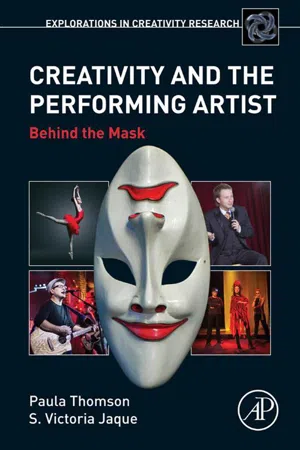
- 500 pages
- English
- ePUB (mobile friendly)
- Available on iOS & Android
eBook - ePub
About this book
Creativity and the Performing Artist: Behind the Mask synthesizes and integrates research in the field of creativity and the performing arts. Within the performing arts there are multiple specific domains of expertise, with domain-specific demands. This book examines the psychological nature of creativity in the performing arts. The book is organized into five sections. Section I discusses different forms of performing arts, the domains and talents of performers, and the experience of creativity within performing artists. Section II explores the neurobiology of physiology of creativity and flow. Section III covers the developmental trajectory of performing artists, including early attachment, parenting, play theories, personality, motivation, and training. Section IV examines emotional regulation and psychopathology in performing artists. Section V closes with issues of burnout, injury, and rehabilitation in performing artists.
- Discusses domain specificity within the performing arts
- Encompasses dance, theatre, music, and comedy performance art
- Reviews the biology behind performance, from thinking to movement
- Identifies how an artist develops over time, from childhood through adult training
- Summarizes the effect of personality, mood, and psychopathology on performance
- Explores career concerns of performing artists, from injury to burn out
Frequently asked questions
Yes, you can cancel anytime from the Subscription tab in your account settings on the Perlego website. Your subscription will stay active until the end of your current billing period. Learn how to cancel your subscription.
No, books cannot be downloaded as external files, such as PDFs, for use outside of Perlego. However, you can download books within the Perlego app for offline reading on mobile or tablet. Learn more here.
Perlego offers two plans: Essential and Complete
- Essential is ideal for learners and professionals who enjoy exploring a wide range of subjects. Access the Essential Library with 800,000+ trusted titles and best-sellers across business, personal growth, and the humanities. Includes unlimited reading time and Standard Read Aloud voice.
- Complete: Perfect for advanced learners and researchers needing full, unrestricted access. Unlock 1.4M+ books across hundreds of subjects, including academic and specialized titles. The Complete Plan also includes advanced features like Premium Read Aloud and Research Assistant.
We are an online textbook subscription service, where you can get access to an entire online library for less than the price of a single book per month. With over 1 million books across 1000+ topics, we’ve got you covered! Learn more here.
Look out for the read-aloud symbol on your next book to see if you can listen to it. The read-aloud tool reads text aloud for you, highlighting the text as it is being read. You can pause it, speed it up and slow it down. Learn more here.
Yes! You can use the Perlego app on both iOS or Android devices to read anytime, anywhere — even offline. Perfect for commutes or when you’re on the go.
Please note we cannot support devices running on iOS 13 and Android 7 or earlier. Learn more about using the app.
Please note we cannot support devices running on iOS 13 and Android 7 or earlier. Learn more about using the app.
Yes, you can access Creativity and the Performing Artist by Paula Thomson,Victoria S. Jaque in PDF and/or ePUB format, as well as other popular books in Technology & Engineering & Ecology. We have over one million books available in our catalogue for you to explore.
Information
References
Table of contents
- Cover image
- Title page
- Table of Contents
- Copyright
- Foreword
- Preface
- Author Biographies
- Acknowledgments
- Section I: Creativity Theory and Performing Artists
- Section II: Biological Manifestations of Creativity in Performing Artists
- Section III: Development of the Performing Artist
- Section IV: Emotion: Regulation, Resilience, and Pathology
- Section V: Professional Reality of a Performing Artist
- Conclusion/Epilogue
- References
- Index